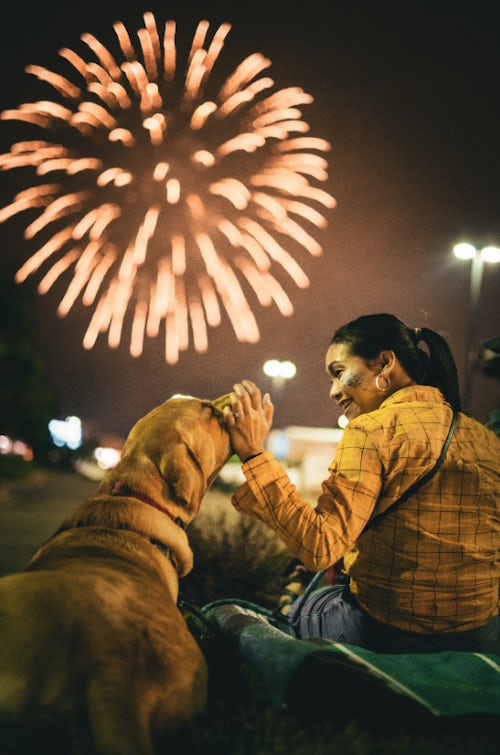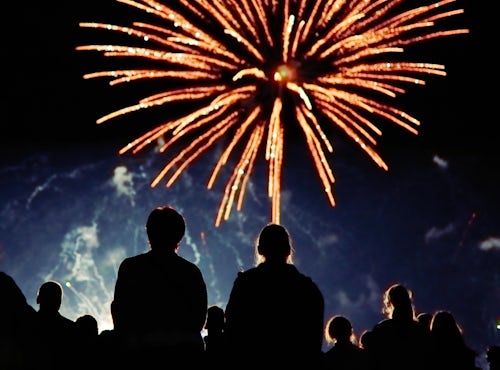As we approach Bonfire Night, Diwali, and other November celebrations, many of us look forward to the vibrant lights and dazzling displays that fireworks bring. But for our dogs, these loud bangs, unexpected sounds and bright flashes can be confusing and terrifying. If your dog struggles with fireworks, you’re not alone—many pet parents experience this, and there are ways to make it easier for both you and your four-legged friend.

Why Fireworks Scare Dogs
Dogs have incredibly sensitive hearing—up to four times as acute as ours. That means what might sound exciting to us can feel overwhelming and frightening to them. The suddenness, unpredictability, and volume of fireworks can make dogs anxious, fearful, or even aggressive as they try to make sense of the noise. Some dogs may react by barking, shaking, hiding, or even attempting to escape or run.
Below we’ll walk through some ideas to keep your dog feeling safe, calm, and secure this fireworks season.
Create a calm environment indoors
A peaceful, familiar indoor space can be a great retreat for your dog. Here’s how to set it up:
- Choose a safe spot: Set up a comfy corner in a quieter part of the house where your dog can hide if they feel anxious. This could be their crate, a comfortable bed, or a corner you can add comfort to.
- Muffle the noise: Close the windows, draw the curtains, and play calming background sounds, such as classical music or a white noise machine. These sounds can help drown out the bangs and crackles outside.
- Familiar smells and comforts: Scatter their favorite toys, blankets, and perhaps an old shirt of yours around their safe space, as familiar scents can help dogs feel secure.
Classic FM’s Pet Classics
Charlotte Hawkins and Dan Walker present Classic FM’s Pet Classics, the annual radio show to help your pet relax during fireworks season. There are two special programmes designed specifically for pets from 5pm to 9pm on Saturday 2 November and Tuesday 5 November, when firework season is in its peak, for the most calming classical music.
Stick to a routine
Dogs find comfort in predictable routines, so try to keep feeding, walking, and playtime consistent during this period but plan walks earlier in the day, before dusk when fireworks are likely to start. Maintaining a routine reassures your dog that everything is normal and under control, even if things sound a bit different outside.
Use distractions wisely
Provide distractions to keep your dog engaged and focused on something positive:
- Treat-filled toys: Chew toys or treat-dispensing puzzle toys can keep their minds busy and help release calming endorphins.
- Interactive games: Play simple games indoors, like hide and seek with treats or engage them in light training sessions. These activities can give your dog something enjoyable to focus on and use their nose to keep them occupied.
- Licky treats: Some dogs love the challenge of licking treats from frozen Kongs or mats, which can be calming and rewarding.
Consider calming aids
There are various products and techniques available that can help calm your dog during firework displays:
- Calming coats: These snug-fitting vests can provide a sense of security through gentle, constant pressure. Many dogs feel more at ease while wearing them.
- Natural remedies: Calming sprays, plug-ins, and supplements that contain soothing ingredients like lavender or chamomile can sometimes help to reduce anxiety. Consult your vet first to ensure these are safe and suitable for your dog.
- Professional help: In extreme cases, your veterinarian can recommend anxiety medications to help manage your dog’s fear. This may be a good option if your dog has severe phobias or shows signs of extreme distress during fireworks.
Practice calmness yourself
Dogs are incredibly perceptive to human emotions, so staying calm is essential. If you’re anxious or over-reassuring, it may reinforce your dog’s worry. Instead, try to act relaxed and go about your evening as usual. If your dog seeks comfort, let them stay close, but remain calm and reassuring without making too much of a fuss.
Be cautious with outdoor time
If you do need to take your dog outside during firework season, be mindful of safety:
- Double-check IDs: Make sure your dog’s collar has up-to-date ID tags with your current information on (your name and address including postcode is a legal requirement), and that they’re microchipped and registered, just in case they get startled and run off.
- Avoid late walks: Plan walks, and bathroom breaks early in the evening, as fireworks usually begin after dark. By limiting nighttime trips outdoors, you reduce the chances of your dog being startled.
Plan for long-term desensitisation
If fireworks are an annual source of stress for your dog, consider starting desensitisation training early. Over time, introducing firework sounds at a low volume on the tv or your phone while providing treats and praise can help your dog develop a more positive association. This training requires time and patience, so it’s best to begin well ahead of firework season, but it’s better late than never so best to start whenever you can ��– every little will help.
Watching for signs of stress
If your dog is displaying symptoms such as panting, pacing, excessive barking, or trying to hide, these are obvious signs of stress. Other symptoms might include trembling, excessive drooling, or loss of appetite. If these symptoms persist or worsen, it’s always wise to speak with your veterinarian for further guidance. An online vet consultation with Joii is great place to start, with access to an expert 24/7.
Ending on a calm note
Remember that your dog looks to you for reassurance, and with the right preparations, you can make fireworks season much less daunting for both of you. The key is to plan ahead, set up a comfortable environment, and use any calming techniques that work best for your individual dog. Here’s to a safe and stress-free November for you and your four-legged friend!


.png?ixlib=gatsbyFP&auto=compress%2Cformat&fit=max&w=70&h=70)